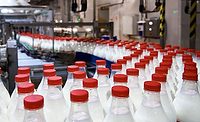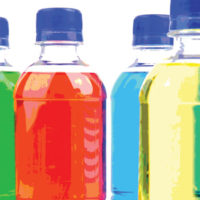The Safety of Beverages in Plastic Bottles

With bisphenol A (BPA) and polyethylene terephthalate (PET) consistently in the mass media with regard to beverage packaging, beverage processors must manage the vast amount of misinformation that abounds and maintain strict standards of beverage safety. While cognizant of consumer concerns, beverage manufacturers must insist on transparency and continue to reassure consumers about product safety. Below are common questions that beverage and food manufacturers must answer to reassure customers of the safety of their products.
So how much of what we read about the safety of plastic bottled water containers is factual or just a plain modern-day urban myth?
“What a lot of people don’t realize is that the U.S. Food and Drug Administration (FDA) stringently regulates bottled water as a packaged food product. FDA has strict standards of quality and clear standards of identity for bottled water that protect consumers. FDA is also charged with ensuring the safety of the materials that package all food products, including bottled water. All plastics (and other materials) intended for contact with foods or beverages are regulated by FDA to help ensure their safety,” says Joe Doss, president and CEO of the International Bottled Water Association (IBWA).
A large percentage of bottled water is packaged in plastic containers, which includes those made from PET, polycarbonate and high-density polyethylene (HDPE). Although aluminum cans and glass containers remain popular, most single-serve beverages, including bottled water, sold in the U.S. today are bottled in 100% recyclable PET plastic. (Aluminum cans are the multipack leader.) Plastic is popular for beverage containers because it is lightweight, strong and extensively tested for safety; it has been around for more than 100 years and has revolutionized the way we live.
The scientific testing of all plastic containers looks at two specific aspects: establishing that there is a minimal amount of transfer of substance between plastic food packaging and its contents, and establishing that any substances that may transfer from the plastic to the food do not pose a risk to human health.
How does one verify safe packaging?
FDA carefully reviews all packaging substances that come into contact with food and beverages. As part of its review, FDA assesses the migration or potential migration of plastics and substances within plastic into the liquid contents. FDA has found that the levels of migration to food of the substances in plastics are well within the margin of safety based on information available to the agency (i.e., toxicological testing has demonstrated that the cumulative dietary concentration of these migrants resulting from the use of the plastic materials in food packaging is at least 100- to 1,000-fold lower than the level at which no toxic effect was observed in animal studies). This means no short- or long-term health effects are likely to occur, even from life-long, daily dietary exposure to these substances migrating from plastic food-contact materials.
Do PET bottles release dangerous substances when exposed to high or freezing temperatures?
It’s important to understand that single-serve PET plastic bottles do not contain compounds capable of producing dangerous substances under conditions of normal use, including being subjected to hot cars or placed in a freezer. The Johns Hopkins Bloomberg School of Public Health has weighed in on the issue of freezing bottled water. Its website states: “This is an urban legend. Freezing actually works against the release of chemicals…[freezing] would limit chemical release if there were dioxins in plastic, and we don’t think there are.”
FDA has reviewed migration-testing data and has concluded that PET containers do not leach harmful amounts of substances into their contents even under extreme conditions of use. With respect to leaving bottled water in a hot car, FDA has stated: “It is true that exposing the bottle to higher temperatures may imply a greater degree of migration of substances from the plastic to the water [or other beverages in similar containers]. However, in its safety review, the FDA takes into account exposures to higher temperatures, such as during storage and transportation of bottled water prior to sale, in its estimates of potential levels of migration of substances from the plastic to the water.
“The levels of migration expected, including during periods of exposure to elevated temperatures in storage and transport (such as might be experienced in a closed vehicle in the sun) have, as discussed above, been determined by the agency to be well within the margin of safety. Therefore, the agency does not consider this situation to be a safety concern.”
What is the safety record of polycarbonate plastics?
Recent media stories have raised questions about the safety of polycarbonate plastic bottles due to the presence of a substance known as BPA. Polycarbonate plastic is used in a wide variety of consumer products, including food and drink containers. Many 3- and 5-gallon bottled water containers are made of polycarbonate plastic and consumers can remain confident about the safety of these products.
Polycarbonate plastic has been the material of choice for food and beverage product containers for nearly 50 years because it is lightweight, highly shatter-resistant and transparent. During that time, many studies have been conducted to assess the potential for trace levels of BPA to migrate from polycarbonate bottles into foods or beverages. The conclusions from those studies and comprehensive safety evaluations by government bodies worldwide are that polycarbonate bottles are safe for consumer use.
What is FDA’s stance on BPA?
On October 28, 2008, FDA issued a statement in response to a report by an FDA Science Board Subcommittee that raised questions regarding FDA’s safety assessment of BPA. FDA agreed that more research “would be valuable” and the agency is “moving forward” with additional planned studies.
That statement also reaffirmed the agency’s position regarding the safety of BPA. It said: “Consumers should know that based upon all available evidence, the present consensus among regulatory agencies in the United States, Canada, Europe and Japan is that current levels of exposure to BPA through food packaging do not pose an immediate health risk to the general population, including infants and babies.”
Do plastic water bottles have a “shelf life?”
Container producers and bottlers continually conduct shelf tests of finished products over varying time periods and under various conditions to help ensure the safety and integrity of the package and its contents. Bottled water is considered a shelf-stable product, and there is no information linking safety concerns with bottled water sold up to two years after bottling. Some large retailers require all food suppliers (including manufacturers of bottled water and other beverages) to carry a two-year expiration date. Production-date coding is popular with retailers for stock rotation purposes.
FDA, which regulates bottled water as a packaged food product, has not established a shelf life for bottled water. IBWA advises consumers to store bottled water (and all other beverages in plastic containers) at room temperature (or cooler), out of direct sunlight and away from solvents and chemicals such as gasoline, paint thinner, household cleaners and dry-cleaning chemicals. In terms of storage and handling, consumers should treat bottled water with the same care and respect as other packaged foods and beverages.
What happens to plastic food containers that are stored in sunlight?
Plastic food containers, including those used for bottled water, do not include additives to prevent the effects of ultraviolet (UV) light. Those effects may be seen in products such as plastic outdoor furniture, which when left outdoors in the sun may eventually turn color or become brittle. Many plastics used outdoors may contain additives (so-called UV stabilizers) to at least slow down this process, but plastic beverage bottles do not contain such additives and, as a result, the plastic may become weakened and develop leaks over time. The guidance on direct sunlight is based on general properties of plastics rather than anything specific to the package contents.
What conclusions can be drawn from these facts?
Misleading statements about plastic containers are all too commonly repeated, not only on the Internet, but within our communities. But with all these facts in hand, beverage and food manufacturers are better equipped to deal with their customers’ concerns and can confidently reassure them that plastic is a safe food-contact material that has been thoroughly and exhaustively investigated by FDA and several international organizations.
“What Internet scaremongers don’t understand is that FDA’s clearance process includes stringent requirements for estimating the levels at which such materials may transfer to the liquid,” says Doss.
He concludes, “There is currently no indication that contaminants from migration or from the water source are a problem in bottled water. Plastic food and beverage containers meet or exceed all FDA requirements.”
Jill Culora is a freelance writer, specializing in health, science and consumer news, and is a media consultant to the International Bottled Water Association.
Looking for a reprint of this article?
From high-res PDFs to custom plaques, order your copy today!








